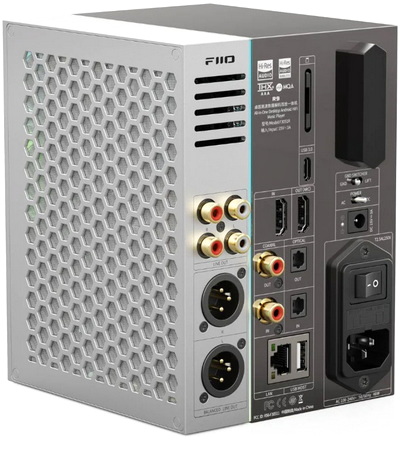CONCLUSION

Even though the R9 was sent to the lab by FiiO roughly two months ago I ended up using it for less than 2 weeks due to some personal issues. The devices I used it with were the FT3 (32Ohm) and FT5 headphones by FiiO, the 109 Pro headphones by Meze (review soon) and the SP3 speakers again by FiiO. Well, it should be no surprise to anyone but the R9 is clearly many steps over the R7 and well, I was also expecting that right from the get-go. Audio quality regarding both mids and highs is improved across the board from detail, clarity, separation, resolution and of course soundstage and as for bass levels well, I seriously doubt you can find many other models (portable and desktop) that can compete with it. Yes, there are probably professional grade players that cost a lot more which could possibly do better in terms of accurate instrument reproduction (at least more among the lines of what professionals want) but again I was more than happy in that area too. As for features the plethora of connectors is nothing short of impressive and let’s not forget that this time over FiiO has equipped the R9 with HDMI ports meaning you can also connect it with your TV or 4k media player and in turn to a set of active speakers like the SP3 I used (or a soundbar). The ability to choose an external power supply unit to further improve audio performance may not be something I’d personally do but I imagine there are very demanding audiophiles out there who would and just having that option is a plus. There are a couple of things I didn’t like about the R9 however, the lack of interior storage space (sufficient one) and the 6-inch LCD screen (not large enough). For such a price I don’t think it would have been hard for FiiO to give the R9 enough storage space for most uses. FLAC HR and MQA audio files are not small and so less than 46GB available is nowhere near enough for such use, not if your audio library is large (even more so if you install apps in it). Yes, the SD card slot allows you to do that but again, even 512GB of internal storage space would be a very convenient feature for many people. As for the 6-inch screen when the R7 has a 5-inch one I do think FiiO should had added a screen of at least 2-inches larger. I do realize that they might have done so to produce a compact model, but I personally think that it would look a lot better if the R9 seemed a far more premium solution compared to the R7 (we are talking about double the price after all). One last thing I need to point out is that even though the R9 comes wearing Android OS 10 (even with firmware version 1.0.4) FiiO has stated they will give it Android OS 12 with a future firmware update so that too is good news (if it happens of course). Last thing i need to clarify is that FiiO allows you to control the R9 from your smartphone with their Cast app. May not be quite the same as some more complete apps since it basically mirrors the screen of the R9 onto your smartphone but it gets the job done (which is why i updated the pros and cons of this review).
The R9 already counts 5 months in the global market and retails for USD1499 inside the USA (Amazon.com) and for around 1490Euros inside the EU so again, it’s not what I’d call affordable. At the end of the day the main question is whether or not it’s worth spending twice as much for an R9 compared to an R7 and the answer is yes, if you can afford it and need the boost in audio quality and of course all the extra features. Don’t forget that the source is only half of the equation so if you can’t pair the R9 with let’s say at least the FiiO FT5 or the Meze 109 Pro (even the SP3 didn’t see quite enough for the R9 which is why my guess is that FiiO is already working on a new pair of speakers) then I don’t see much of a reason. With that out of the way however I can’t deny that the R9 is the best DAC/Amp/Streamer to arrive in the lab (to date) and for that the Platinum Award is in order.

PROS
- Near Excellent Build Quality
- Impressive Audio Performance
- Supported Bluetooth Codecs (SBC/AAC/aptX/aptX HD/LDAC/LHDC)
- 5.99” Touchscreen (1080x2160p)
- Octa Core Qualcomm Snapdragon 660 14nm SoC
- Dual 8 Channel ESS Sabre ES9038PRO DACs
- 8 Channel THX AAA-788+ Onboard Headphone Amplifier
- XU316-1024 XMOS 32 Bit Multicore Microcontroller
- 4GB LPDDR4 RAM
- Available Inputs / Outputs (4 Pin XLR/4.4mm Balanced/6.35mm/Dual 3 Pin XLR Balanced Ports/RCA/Optical/Coaxial/HDMI ARC/RJ45/USB A/USB C)
- External DC Power Supply Support
- Bluetooth 5.1 & WiFi 2.4G/5G
- SD Card Slot (Up To 2TB)
- 64GB Onboard Storage (46GB Available)
- Supported Audio Formats (DSD/ISO/DSF/DFF/DST/DXD/APE/Apple Lossless/AIFF/FLAC/WAV/WMA/MP3/OGG/AAC)
- Open Android v10.0 OS (Future V12 Update?)
- ARGB LED Rings & Strip
- RM3 Bluetooth Remote
- Flat & Angled Rubber Bases
- Product Support
CONS
- Price (For Some)
- Almost Identical To The R7 (Design / LCD)

 O-Sense
O-Sense







.png)

